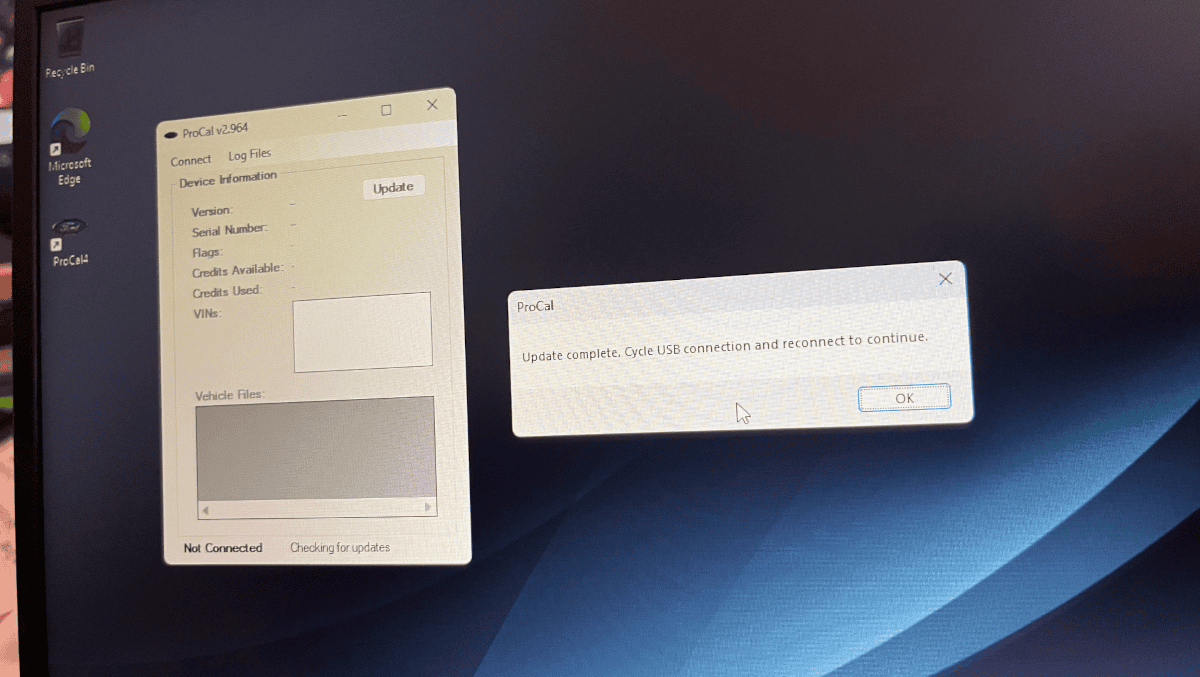Although most of my articles are about owning and using the Bronco Sport, we also own a 2-door 2023 Iconic Silver Bronco Badlands with the 2.7L EcoBoost engine. This article discusses installing a Bronco performance calibration, the Ford Performance ProCal 4, in your Bronco.
Driving Woodward in a Ford Performance Bronco
During a trip this summer to Detroit for the Woodward Dream Cruise, we drove one of the Ford Performance Broncos and noticed that it had a very nice throttle response, and the shifting was very sporty, considering it had the 2.3L engine. After a little inquiry, we learned about the ProCal 4 and added it to our list of upgrades for our Bronco.
We Ordered Online and Santa Delivered
The ProCal 4 is a performance calibration that is available for both the 2.3L engine as well as the 2.7L engine and can be purchased directly from the Bronco Nation store. Bronco Nation members receive a discount.
The Ford Performance website promises you’ll see enhancements to both power and performance without sacrificing reliability.
We ordered one for Christmas, and I thought I would write up how easy this device is to install to upgrade your existing stock software. The small box arrived via Santa, containing a delivery tool, a cable to connect the device to the OBD II port, and a USB/charging cable, along with a ziplock with the instructions and registration number.

If you’re one of those people that wants to check out all the details first, you can read the instructions here before ordering.
Installation Is Easy; We Did a Hybrid Option
Before installation, a key decision needs to be made: Do you want to do the installation yourself or have it installed by an ASE/Red Seal Certified technician/Ford dealer. When done by the latter, there is the promise of the continued 3 year/36k mile warranty. We reached out to Ford Performance Parts for more information on the warranty and were told that any warranty-related repairs were up to the decision of the Ford dealer.
Although we could not foresee how there would be any warranty problems with a self-install, we spoke with an ASE Certified technician and decided to keep that full warranty by creating a hybrid option; we would prepare the install tool and have a laptop prepared with all the steps leading up to the actual connection with the on-board diagnostics (OBD) II. In our case, by doing this, we were charged for only one shop hour, about $130.00. With only 8,000 miles on our Bronco, we decided to minimize any hassles and elected to use this option.
Installation Steps
If you’re still reading this, then you’re interested in doing all or some of the installation process yourself, so on we go.

The first step was to create an account at the Ford Performance Parts website. There, we could download the software and install it on a PC (not a Mac). You need to verify your registration number included in the product box before you get access to the software. Next, connect the delivery tool –– the small Ford Performance box –– to the laptop. During our download, the device’s software was also updated. This took a few minutes to perform, and the tool itself didn’t do anything other than show what is called the “splash” screen. All the activity was on the laptop screen, informing us of what was happening and when it was complete.

Connecting with an ASE Certified Technician
Once that was finished, we took our Bronco to the technician, who connected the Bronco battery to a tender as recommended in the instructions. We also disconnected the Bluetooth connection to our phones.

An important step before connecting the tool to the OBD II port, is to key the start button on the Bronco without starting the engine. (Keep your foot off the brake and press START.) Next, he connected the delivery tool to the port, selected the Programming Option on the tool and followed the prompts to download the Bronco’s existing stock calibration. This happened so quickly that we wondered if the device was simply verifying the VIN instead of downloading software from the Bronco.
He then unplugged the tool from the port and connected it back to the laptop to verify the VIN and install the performance calibration. Following that, he reconnected it to the OBD while the Bronco was in the run position (keyed on, engine off). Following the prompts on screen, he selected Programming and the Performance Calibration upload began. The instructions stated to expect various chimes and alarms to sound in the Bronco, but not much happened besides the warning lights on the dash display. There were no further instruction prompts other than the finish signal, “Clearing Codes, Finished, Key off for 3 seconds.” Turning the Bronco off was the finish of the installation, and that was it! The tech commented that it was one of the easier calibrations he’s performed and thought it was because it’s from the manufacturer.

The Bronco Initially Handled Rough but Quickly Smoothed Out
We drove the Bronco home and noticed that initially the transmission shifts seemed a little harsher than before, but this quickly resolved to a nice smooth shift pattern, less than 10 minutes into driving.
There is a definite, noticeable difference in throttle response, and some of the “lagginess” when first accelerating from a stop was gone. It reminded me of the difference in my Bronco Sport between the Normal G.O.A.T. Mode and the Sport Mode. It’s zippier, responsive, and very smooth shifting. According to the Ford Performance website, with our engine, we gained 40hp (355hp) and 20 ft/lbs of torque (433ft lbs), but that optimized shift pattern and throttle response is where our Badlands really started to shine and makes it a real pleasure to drive on pavement.
We installed the calibration just over a week ago, and there is a glitch … our seatbelt chime is silent. The dash display is there, recognizing if there are 1 or 2 seatbelts fastened, but the “ding-ding” is gone. We are really good about always wearing seat belts, but there have been times when, well, the chime is annoying. We poured through the information to see if this was an added “feature,” but apparently it is not. We haven’t had time to contact Ford Performance to see if this is a known issue, but we’re not complaining.
Other Calibration and Data Collection Options
Besides just the performance calibration, there are some other enhancements. One of the future uses we’ll take advantage of is for tire adjustment. The tool will allow calibrating the speedometer/odometer for tire sizes up to 37”. We plan on moving up to 35” tires, and it’ll be great to easily change that. Gearing adjustment can also be performed with the tool, up to 5.38 and allowing a change to the front drive unit from M190 to M210. The tool will also read diagnostic codes and can clear those as well. There is also a real-time gauges that can monitor spark timing, air/fuel ratio, RPM, etc. if that’s something you’re interested in.
Have you installed the ProCal 4 in your Bronco? Did you do it yourself or take it to the dealer? Have you noticed any issues, and are you pleased with the performance? Comment below.

Comments
You must log in or register to post here.